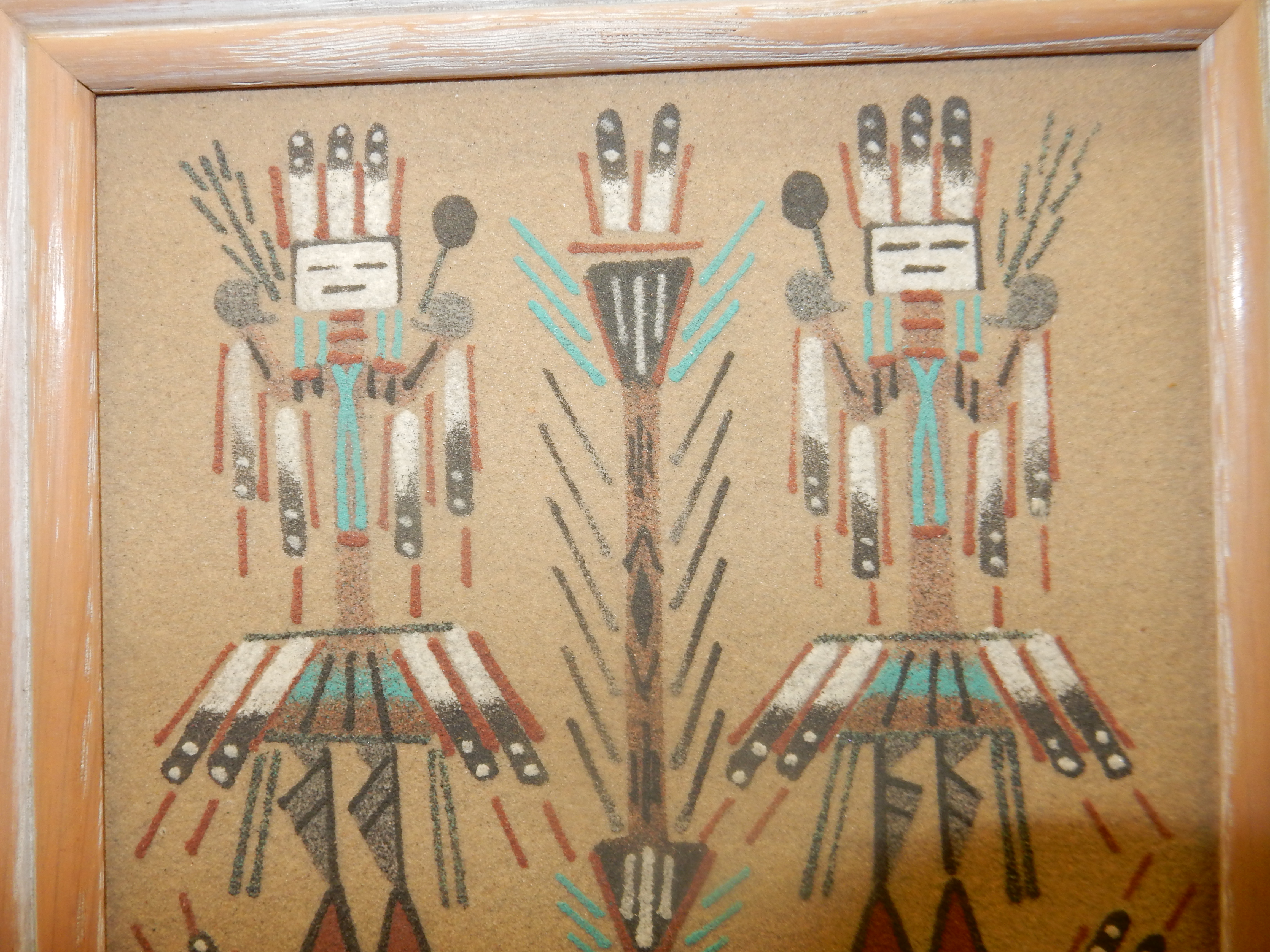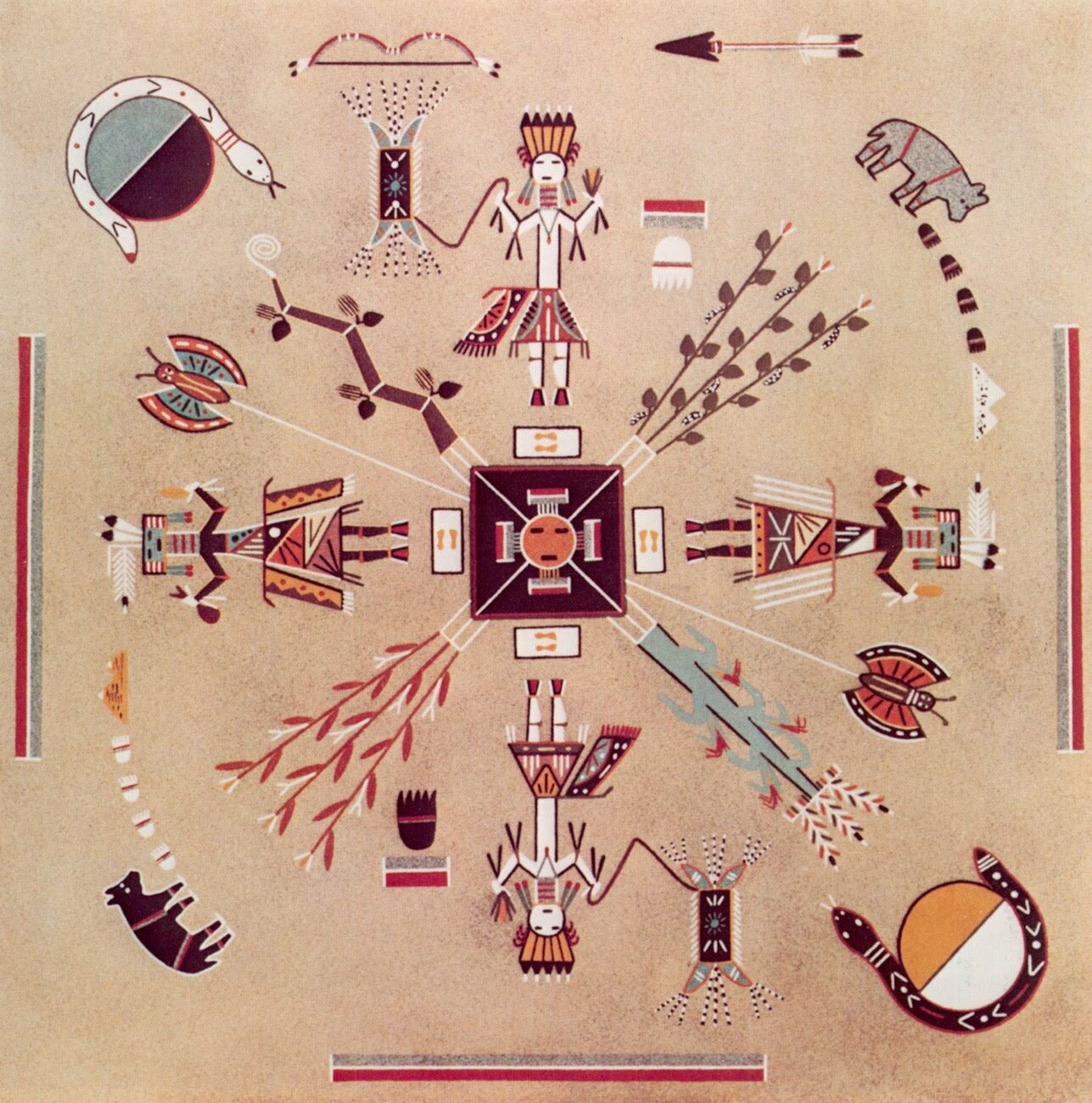Unfixed sand paintings have a long established cultural history in numerous social groupings around the globe and are often temporary ritual paintings. The Navajo Sand Painting is a symbolic representation of some portion of Navajo mythology and is a big part of the lengthy curing rites and is used by most tribes in the Southwest.

A History Of Graphic Design Chapter 78 Navajo Indians Sand Painting
The Navajo Sandpainting WeavingPreserves Tradition and Ceremony.
. Snakes are seen in Navajo sand paintings and other artworks. The sand paintings are usually created on a Hogan floor and different colors of sand are used to create this painting. Within the Navajo culture there are several symbols that have specific meanings when displayed.
Most art authorities concede that the Southwestern sand paintings produced by the Navajo are the intricate complex and beautiful art-forms. Navajo Sandpaintings also called dry paintings are called places where the gods come and go in the Navajo language. After a ceremony the sand art is destroyed.
They believe that the holy figures in the painting absorb the ailment and provide relief. It is a sacred practice. A medicine man is consulted as to what ceremony is required and often uses divination to decide the matter.
They are used in curing ceremonies in which the gods help is requested for harvests and healing. Navajo sand paintings are made in the mornings and early afternoons of the last days of a ceremony lead by the medicine man and his helpers. Sand painting also called dry painting type of art that exists in highly developed forms among the Navajo and Pueblo Indians of the American Southwest and in simpler forms among several Plains and California Indian tribes.
The Navajo word to indicate the sand paintings is iikaah which means the place where the holy people comes and goes because during the ceremonies There are powerful supernatural forces and only the shaman knows how long it will take to heal what herbs to use. Navajo Symbolism and Sand Painting rites November 7 2009 by Harold Carey Jr ALL ceremonies are for healing either of fears or of bodily ailments and each is a communal affair paid for by the patients relatives. The sick person would sit on top of the sand painting so the healing spirits would come through the painting and heal the sick person.
They are created to aid in the restoration of health and harmony hózh in the life of the patient the one sung over. While a traditional sandpainting is meant to be created and. The snake is also a symbol of the lightning people and brings rain to the dry land.
Although sand painting is an art form it is valued among the Indians primarily for religious rather than aesthetic reasons. The Navajo name for sandpainting iikaah translates to place where gods come and go This name is appropriate because if all activities are performed correctly and the patient believes in the cure the sandpainting prepares the way for the forces or Holy People to intercede and restore hozho. You might find these symbols in their sandpaintings their general artwork and even in their current government structures.
Also known as dry paintings sandpaintings meant places where gods come and go in the native Navajo language. Navajo Sandpaintings from the Navajo Reservation are the finest Sandpaintings of the Navajo today and are found in Penfield Gallery of Indian Arts in Albuquerque. The subjects and patterns of sand paintings are transmitted by memory.
While the only significant venomous snakes present are the rattlesnakes all snakes are avoided. Navajo sandpaintings even though one of the most popular forms of Navajo art were not created to be art but rather a part of a sacred healing ritual or ceremony performed by medicine men. The original Navajo dry painting is traditionally performed for religious or medicinal purposes.
Sandpaintings or better drypaintings iikááh are an essential part of Navajo ceremonials Diné binahagha and as such are sacred. While the Navajo sand paintings have a complex process in which they are created they also have a complex meaning in which they are looked at. The Navajo Sandpainting Weaving is ranked among the Navajo tribes best known and best loved art forms.
The Navajo Indians have developed them to the greatest degree. For theDínehor People as Navajos call themselves sandpainting is a sacred healing art linked tothe time of myth and memory. Poisonous snakes on Navajo land were a real threat to the Navajo and their livestock.
This is referred to by the Navajo as an iikaah a place where the gods come and go The sandpainting is the crucial element in this 2- to-9-day ceremony which is designed to restore balance hozho thus restoring lost health or insuring good things The Singer uses crushed stone crushed flowers gypsum pollen etc. Sand paint ing ˈsand-ˌpān-tiŋ Definition of sandpainting. Sandpainting is the art of pouring coloured sands and powdered pigments from minerals or crystals or pigments from other natural or synthetic sources onto a surface to make a fixed or unfixed sand painting.
For good reason one Navajo term forsandpaintings means place where the gods come and go Once those Holy People-First Man and First Woman First Girl and First Boy Corn People Snake People and others-livedunderground. A ceremonial design as of the Navajo Indians made usually of colored sands on a flat surface also. A beautiful sand painting by the Navajo Indian artist Norman Tom it was made to treat the sick.
The figures in sand paintings are symbolic representations of a story in Navajo mythology. Most of the native languages do not have a word to indicate the traditional medicine that it is called mystery. Sand paintings have been used by the Medicine Man of the tribe to treat people when they develop an illness.
Sandpaintings are used in ceremonies designed to. After the paintings are made and the ceremony has been done the art is then destroyed. The Navajo Sand Painting is a symbolic representation of some portion of Navajo mythology and is a big part of the lengthy curing rites sand paintings are used by most tribes in the Southwest.
The Navajo Indians have developed the sand painting art to the greatest degree and have between 600 and 1000 separate sand painting designs. The Diné is the Navajo name for themselves and the term they use for sand painting is iikááh which means a place where the gods come and go. For the Navajo the sand painting is a dynamic living sacred entity that enables a transformation in the mental and physical state of the ailing individual.

Navajo Sand Painting Native American Trading Co

Meaning Of Indian Symbols Sand Paintings

The Collector S Guide Navajo Sand Paintings

An Art Of Healing Navajo Sandpainting The Old Jail Art Center


0 comments
Post a Comment